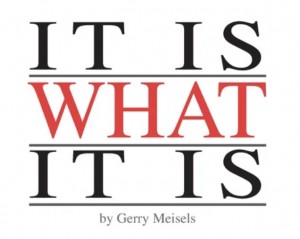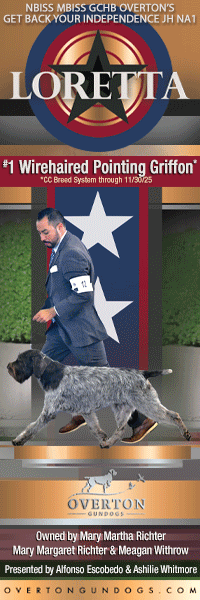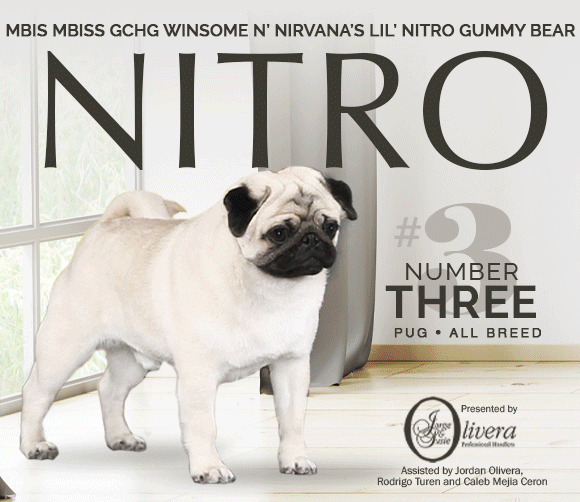From The CC Vault: It Is What It Is
by Gerry Meisels
 Within the last few years, the little phrase “It Is What It Is” seems to have become ever more popular, and we see it crop up more and more often. I first heard a professional handler use it, and today I hear it not only at the shows and at kennel club meetings, but even in my job. I believe that the phrase reflects acceptance of realities that are beyond our power to change. It also reflects resignation, disillusionment and acceptance of bad conditions. While it is defeatist, it helps us cope with disappointments and frustrations in the clash between what we believe would be a fair outcome and the actual outcome that does not live up to our ideals of objectivity. There is, however, a question of when such a reaction is appropriate, and when it is just an excuse to do nothing and of allowing bad things to happen without working toward a solution.
Within the last few years, the little phrase “It Is What It Is” seems to have become ever more popular, and we see it crop up more and more often. I first heard a professional handler use it, and today I hear it not only at the shows and at kennel club meetings, but even in my job. I believe that the phrase reflects acceptance of realities that are beyond our power to change. It also reflects resignation, disillusionment and acceptance of bad conditions. While it is defeatist, it helps us cope with disappointments and frustrations in the clash between what we believe would be a fair outcome and the actual outcome that does not live up to our ideals of objectivity. There is, however, a question of when such a reaction is appropriate, and when it is just an excuse to do nothing and of allowing bad things to happen without working toward a solution.
I hear It Is What It Is a lot when I listen in on discussions about judging. After a few minutes of complaining about an especially egregious poor judgment in a class, someone will close the conversation with the call for ”getting over it” and to urge resignation to the inevitable. But whether and how it may be beyond our power to change things depends on the time frame. No scolding and punishing will clean up the mess left by your dog on your carpet. So that is what it is. But you would be a very sorry doggie parent if you did not try to train your dog not to repeat that mistake. No amount of complaining will change what has happened in the past. But letting it go at that results in there never being any improvement. The risk of being satisfied with It Is What It Is comes from it being an easy excuse not to try to improve the system, a temptation to give up too soon.
How can one decide when It Is What It Is is the place to stop? To some extent that depends on time scales, personal time demands, and risks. Work on some issues may take a personal investment of months and even years before any fruition could be detected, and even then the outcome may not be certain. How many of us have time on our hands? There are also the risks that come with any such initiative: disagreements with those who believe otherwise, the apprehensions and suspicions that every innovator encounters, and especially contracting the ill will of powerful people, people who are powerful largely because they have learned to succeed in the environment as it now exists. The only thing we know for sure is that if too many just complain but take no action, they will do nothing but perpetuate and accentuate precisely the kind of conditions to which we object.
One of Murphy’s tongue-in-cheek laws states that bad things left to themselves will make a bad situation become worse. Long-standing problems are usually well known and have been subject to attempts to solve them. Even if none of these ever give the perfect solution, they keep our attention on constructive attempts to solving them. Just the very process of asking the questions again and again will sensitize the prevalent culture to their existence and the need to find more effective ways to dealing with them. When it comes to the perennial issue of the quality of judging and , the easy answer is that evaluating that quality is too idiosyncratic to ever work, not in the least because most exhibitors measure judging quality in terms of their own success. A number of attempts have been made to get past this criticism, such as by differentiating the evaluators on the basis of their experience in the sport. The recent introduction by a number of parent clubs of a process to evaluate individual dogs on a non-competitive basis in which teams of acknowledged breed experts critique potential breeding stock is an indicator that there are many serious breeders who are giving up on conformation shows as meeting their original purpose of evaluating breeding stock. If this becomes more common, it is bound to re-shape the nature of conformation shows in profound ways. Other remedies have taken a somewhat different slant such as sending teams of breed experts to meet with and educate judges found wanting. Most of such people-intensive programs have promise, but are difficult and costly to take to scale. Moreover, such approaches focus strictly on a limited dimension (judges) and ignore other factors that contribute to the absence of a self-controlling approach. A systemic approach will try to identify all factors that contribute to the perceived problems. For example, I don’t remember anyone ever asking how the idiosyncrasies of clubs’ practices of hiring judges contribute to current problems.
The unwillingness to verbalize our concerns, to come to grips seriously with issues of our conformation shows, and the lack of pursuit of constructive “ is a sad admission of the lack of will to improve current practices. It makes It Is What It Is into the defeat we all abhor. If we quit too early, we will fail to “put on the heat until the powerful see the light.” (Senator Everett Dirkson paraphrased). If we settle too soon to be satisfied with It is What it is, we will not join the battle to save and secure the future of any of our endeavors, especially of our conformation shows.
Short URL: https://caninechronicle.com/?p=259495
Comments are closed












